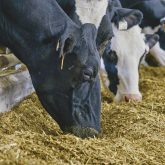Updated, May 17 — The Simpson Centre for Food and Agricultural Policy has released a report detailing its findings on challenges now facing Canada’s poultry sector.
The report, co-authored by research assistant Shawn Wiskar and centre director Guillaume Lhermie and released Thursday, used a focus group of six stakeholders in the Canadian poultry industry. It recommends several measures, primarily focused on increasing research and streamlining existing systems.
Read Also

Ample supplies and improved livestock sector to boost Canadian feed sector: FCC
Abundant feed grain supplies and improved profitability for the livestock sector should support strong feed demand and sales through the winter, says a new report from Farm Credit Canada.
In its conclusion it states that “with the small size of Canadian poultry farms, expectations are placed unfairly on farmers across the country, creating regional strain and limiting the market’s ability to grow.”
Wiskar said the research for the report, which began last year, was “conceptualized out of an idea that it was really important for public policy to be built out of evidence-based and informed policy from producers.”
The think tank, which focuses on ag sector policy analysis and is based at the University of Calgary’s School of Public Policy, “was really trying to function here as kind of a bridge-builder between the government of Canada as well as the government of Alberta and the producer groups,” he said.
The four main policy changes the report recommends are:
- an increase in provincially funded research;
- streamlining of the approval process for vaccines already approved in comparative markets;
- a comprehensive analysis of the poultry supply chains in other countries; and
- increased communication between poultry producers and the federal and provincial governments.
“We certainly hope at the very least this gets a conversation started between the producer groups and the government,” Wiskar said.
“The takeaway message from this report is that we think there is an increased need for efficiency in these markets, and the first step to that is improving communication between the different levels of government, the different commodity groups, as well the overarching marketing board.”
‘Barrier to entry’
Wiskar said that the poultry sector’s quota system was also a topic of concern for its focus group.
“Canadian poultry farms are a lot smaller, and their operations have to be smaller, due to the quota system, when you compare it to something like the beef sector, which doesn’t have that quota system.”
In the section on sector challenges, the report calls the quota system a “barrier to entry in the poultry sector, as farmers must bid to purchase a quota of production.”
The report said its focus group viewed Canada’s supply chain model as “posing the industry’s greatest challenges but also as providing its greatest support,” Participants cited the protection it provides from market fluctuations, but also its tight profit margins.
Wiskar said he didn’t think there was much in the report that would be unknown to producers or governments, but there is plenty the Canadian public could take away from it.
“It kind of seemed to us like the focus group we sat down with really thought that poultry was conceptualized by the public as being something more similar to what you might get out of the United States,” Wiskar said.
In Canada, he added, “poultry farming is a smaller operation, and it’s really bound up in supply management, which is not something that’s particularly well understood by the Canadian public.”
“The chicken farmers and the turkey farmers and the egg hatching farmers, they have different priorities, and they are functionally different industries, so it’s important not to group them all together.”
Asked for a review of the report, Chicken Farmers of Canada, for one, declined comment.
A CFC representative, noting the “limited sample size” of the report’s focus group, said Friday via email it could be misleading or “even risky” to draw conclusions from the report’s methodology.
Egg Farmers of Canada similarly said it had “no specific comment” on the report but also noted it was “based on a focus group that included a small sample of size of six agricultural stakeholders.”
The Simpson Centre is due to release a sister report on the challenges faced by the beef industry in several weeks.
— Jonah Grignon reports for Glacier FarmMedia from Ottawa.
Updated May 17, 2023 to include Egg Farmers of Canada comment.

















